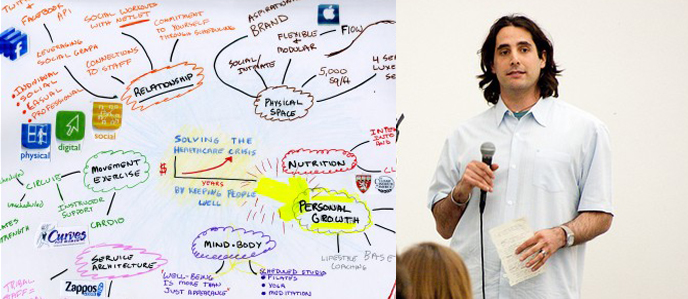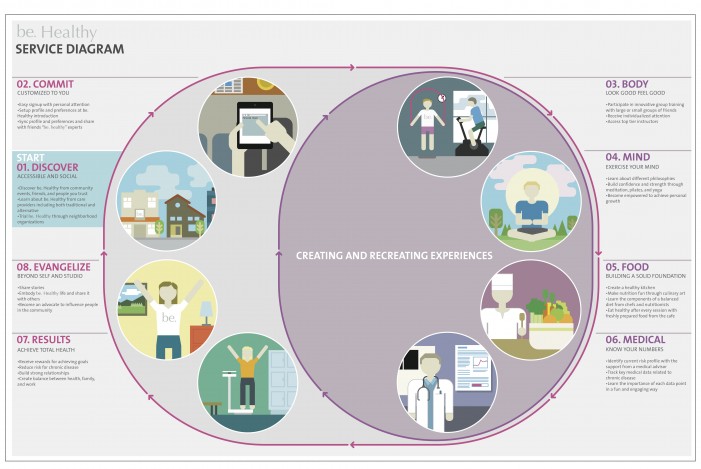Adam Dole | Design Strategist and Innovator

If you want to make a major impact on solving the country’s health care crisis . . . you go to design school, right? OK, so it may not be the obvious choice (yet!), but for Adam Dole (MBA in Design Strategy 2010) it was the best choice, California College of the Arts. He now has his dream job as a business planning manager for Mayo Clinic. He is based in Silicon Valley and serves as a member of a “new ventures” team, focusing on identifying and incubating future Mayo Clinic commercial products, services, and businesses.
Back in 2008, when Dole realized that an MBA was what he needed to take his career to the next level, he knew from extensive professional experience that something was missing from almost all of the programs he was researching. Determined not to go the traditional business-school route, he saw clearly how the hybrid curriculum of CCA’s MBA in Design Strategy program would be perfect for his purposes.
Ready for Anything
Dole leverages his CCA MBA training on a daily basis. He hit the ground running at the Mayo Clinic by being able to effectively identify and evaluate new opportunities using a hybrid approach: Creative thinking defines what is possible, and analytical thinking determines what is required to bring new ideas to fruition. “Our health care system is on the brink of bankrupting our country,” he says. “We are now raising the first generation of children who are expected to live shorter lives than their parents. We can no longer rely on traditional thinking and existing models to solve these problems. Nor will they be solved by incremental improvements in operational efficiencies. Real solutions will require a systems-thinking approach.”
Dole graduated from Syracuse University in 2004 with a bachelor’s degree in communications. He began his career as a research associate in the Human Factors department at NASA, studying astronauts’ biometric feedback under stressful conditions in preparation for long-duration spaceflights to Mars. From there he took a position at Jump Associates, a growth strategy consultancy in San Mateo, California, and then in 2007 he was hired to lead the research department at Method Inc., a San Francisco-based design and innovation consultancy.
In 2008, he had two distinct realizations that impacted his career trajectory dramatically. One was the disheartening reality that a human-centered design mindset is sorely lacking in the Fortune 500 realm. Company leaders consistently ask the wrong questions when it comes to thinking about how to grow their businesses or gain competitive advantages. “Today, established, long-standing business models are being challenged by nontraditional competitors that didn’t even exist three years ago,” Dole says. “As new competition begins to gain traction and market share, more established companies end up competing on price and increasing efficiencies, usually resulting in shrinking margins and diminished customer satisfaction. Competing on cost with razor-thin margins is not a sustainable solution when new companies in your field are taking a human-centered, design-thinking approach and reframing emerging opportunities to create new value for customers.
“My second realization was something that I could no longer ignore — something that started keeping me up at night,” he continues. “I wanted to have a major impact on solving our country’s health care crisis.” Knowing that the typical four-to-six-month consulting engagement would not be sufficient to effect deep changes, Dole decided to explore graduate programs that would equip him with a unique skill set to exert a meaningful impact.
Choosing the Right Fit
The traditional curriculum espoused by many highly respected business schools wasn’t going to work for him, it was clear. “In recent decades, we have seen older business models struggle to remain relevant in a rapidly changing economic landscape,” says Dole, “and yet business school curricula are still largely unchanged. These programs appear to be more concerned with maintaining their long-standing brand reputation than with reinventing themselves to provide students with the most relevant skills necessary to create and lead change in an evolving and increasingly ambiguous business landscape. We need more change agents, not more B-school analysts who are great with Excel.
“When I discovered CCA’s MBA in Design Strategy program, I was impressed by its hybrid curriculum and approach — how it deliberately combines principles from both design and business. The program is mindfully designed to provide students with the toolkit and the confidence to lead systemic change across any industry or economic climate.”
From the Classroom to the Boardroom
With insights gained through his work experience and new CCA degree, Dole was perfectly positioned for his current role at the Mayo Clinic. The Mayo Clinic is a world-renowned nonprofit health care institution — a leader in medical care, research, and education. Dole describes his job role as an “entrepreneur in residence”; he is responsible for identifying and incubating future products, services, and businesses that leverage the Mayo Clinic’s unique ability to address unmet patient and consumer needs. The idea is to extend the Mayo Clinic’s reach beyond the walls of the hospital, with the hope of preventing hundreds of millions of people worldwide from ever needing to visit the Mayo Clinic (or any other medical facility).

The Mayo Clinic Healthy Living storefront at the Mall of America
One example of this is Mayo Clinic Healthy Living at the Mall of America in Minneapolis, which opened last August. It is part health and wellness service, part retail store. Dole and his colleagues designed this new space for the “live” testing of prototype health and wellness services aimed at a broad consumer market. It is run by a staff of Mayo Clinic “health navigators” and coaches trained in helping customers assess their current health status, define their wellness goals, and gain access to information and resources. Think of it as interactive “store” for health.
More recently, Dole has been focusing on defining a new mobile health business for the Mayo Clinic. He can’t say too much about it yet, but he is clearly excited about the new venture and believes it could have a major impact on how millions of people understand health and experience health care.
“The design process often involves an initial period where the answers are unknown and the opportunity spaces may be ambiguous at best,” says Dole. CCA’s Design Strategy MBA curriculum lends itself well to this. “Designers tend to be comfortable with this level of ambiguity, and approach ambiguous problems by collaborating in interdisciplinary teams in order to understand what questions we should even be asking in the first place. They get out into the world to spend time with their target audiences in order to develop a deep understanding of unmet needs before devising solutions.”
CCA as an Incubator
Dole approached the MBA in Design Strategy program as a two-year incubator for the exploration of new solutions. “Each semester I focused on a different aspect of the industry’s ecosystem,” he says. “I ended up designing numerous projects that, along with the supporting curriculum, helped me develop a unique point of view around creating new value propositions and customer experiences in health care.
“One of my favorite courses was Venture Studio (our thesis class) taught by the serial entrepreneur Asher Waldfogel and the highly talented design strategist, https://www.cca.edu/academics/graduate/design-mba/bwurz”>Bill Wurz. I worked with my classmate, Paul Colando, on a venture project called be.Healthy, an integrated health and wellness service intended to address the growing epidemic of chronic disease in our country. We used positive social support and tight feedback loops to motivate people to establish and sustain healthy behaviors and habits.” This holistic targeting of mind, body, and nutrition was intended to make a healthy lifestyle seem fun, social, and sustainable.
Most importantly, Dole reports that the program taught him how to take an idea and turn it into a fundable and sustainable business. Because his job requires him to create new businesses within the arms of the Mayo Clinic, this kind of from-the-ground-up thinking has been invaluable.

Service diagram for be.Healthy, a project Dole worked on at CCA with fellow student Paul Colando.
Awards and Accolades
Already he has been widely recognized for his innovations in the field. In 2009 he won the InnoCentive Healthcare Ideation ChangeNow4Health Challenge, and in 2010 he was named a semifinalist by Launch.org, a global initiative between NASA, USAID, the State Department, and Nike to showcase and support innovative approaches to global challenges. Most recently, Dole was awarded a Front-Line scholarship to attend TEDmed, where he was surrounded by many of the world’s most creative minds across all industries, brought together to inspire, shape, and create the future of health and medicine.
“Being a change agent inside of a large company trying to disrupt the existing healthcare system requires me to approach challenges and roadblocks as opportunities. The opportunity to eradicate preventable chronic diseases through new products, services, and businesses is what keeps me up at night . . . and makes me excited to go to work every day. I am thrilled to be working in an industry that needs more people who believe in leading change and thinking differently to do it.”
Related Links:
Four Things Video Games Teach Us About Motivating People, by Adam Dole, on Fast Co.
Originally Posted on Monday, April 30, 2012 by Allison Byers
https://www.cca.edu/news/2012/04/30/design-does-body-good-dmba-alum-adam-dole-uses-design-thinking-reframe-health-care-s